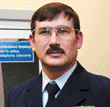Small firms make big difference

<FONT SIZE=2>When L&E Associates learned about the Coast Guard's Rescue 21 modernization effort to upgrade its 30-year-old search and rescue communications system, the company was determined to find a way to be a part of it.</FONT>

L&E's selling point as a partner was its four years of experience providing facilities management services to the Coast Guard, as well as its statusas a small, disadvantaged and veteran-owned business, said Nat Thomas, vice president of business development.
Henrik G. de Gyor

"The marine environment is a very unforgiving environment," said Coast Guard Cmdr. Ed Thiedeman, acting project manager on Rescue 21. "When you're in danger on the sea, especially if you end up in the water because your vessel sinks, time is critical."
Henrik G. de Gyor

"The RFP did not specify a goal, but it did state that (bidders') small business plans would be reviewed as part of the selection process." ? Ellen Murray, Coast Guard contracting officer on the program
Henrik G. de Gyor
But company officials knew the Oxon Hill, Md., firm was too small to bid as a prime, so it did what many small businesses do: stepped up its efforts to catch the eye of potential prime contractors.
"We identified ... three that appeared to be the ones to bid on it" -- General Dynamics Corp., Lockheed Martin Corp. and Science Applications International Corp., said Nat Thomas, vice president of business development at L&E.
L&E's selling point as a partner was its four years of experience providing facilities management to the Coast Guard, as well as its status as a small, disadvantaged and veteran-owned business, Thomas said.
L&E executives pursued the three large systems integrators, identifying their business development people and calling repeatedly. Lockheed Martin and General Dynamics both picked L&E as a teammate after investigating its past performance and capabilities.
The persistence paid off for L&E when General Dynamics, Falls Church, Va., won the $611 million contract.
"L&E really earned the right to be on the team," said Ericka Moyer, the Rescue 21 contract manager at General Dynamics. "They're very well thought of by the Coast Guard. They were very responsive to our needs, whatever we needed during the solicitation phase."
L&E's experience shows how small companies can find a niche for themselves, especially when larger, more established players seem to have an edge in new areas of business, such as homeland security.
"With the way this administration is attempting to achieve more consolidation of IT programs and projects across the entire government, it becomes more difficult for small businesses to compete for these larger programs on their own," said Ray Bjorklund, vice president of research with Federal Sources Inc., a McLean, Va., market research firm.
Consequently, small businesses need to be proactive in seeking partners that can help them get in the door while they build their credentials.
"If you stand out well as a subcontractor, the government doesn't forget that," Bjorklund said.
At the same time, large firms such as General Dynamics need small businesses, both for specialized skills and capabilities, and because the government usually has some requirement for small-business participation.
"We want to get the best performer, whether they're a small or a large business," Moyer said.
As new opportunities arise, the company begins thinking about small-business participation, even if the government hasn't issued a requirement.
"We try to get ahead of the power curve," Moyer said. "We don't wait on the government's number."
The Coast Guard did not set hard targets for small-business participation on Rescue 21, said Ellen Murray, the Coast Guard contracting officer on the program. "The RFP did not specify a goal, but it did state that [bidders'] small-business plans would be reviewed as part of the selection process," she said.
General Dynamics puts a lot of effort into working with companies such as L&E, Moyer said. There are eight subcontractors on the project, two of which are small businesses -- L&E and Communications Services Inc. of Mesa, Ariz.
"We have a Web site where we encourage companies to talk about their capabilities," Moyer said. "It's quite an extensive list; it varies by commodity and capabilities. We have people who go out in the field at trade shows [to] find companies and encourage them to sign up."
Rescue 21 is officially called the National Distress and Response System Modernization Project and is akin to establishing a 911 system for boaters. The program is intended to improve the Coast Guard's ability to detect mayday calls, pinpoint their location and coordinate rescue operations along the 95,000 miles of U.S. coastline and interior waterways.
"The marine environment is a very unforgiving environment," said Coast Guard Cmdr. Ed Thiedeman, acting project manager on Rescue 21. "When you're in danger on the sea, especially if you end up in the water because your vessel sinks, time is critical."
The system will cover the coastline up to 20 miles offshore, including the Great Lakes and other major interior waterways. Currently, the Coast Guard cannot hear distress calls from about 14 percent of these areas. The new system will reduce those gaps to less than 2 percent.
The contract General Dynamics won is worth $611 million for six years with two four-year options and one five-year option. The work could last almost 20 years.
Another small business on the Rescue 21 project, Fuentez Systems Concepts Inc. of Charleston, S.C., was sought out by General Dynamics following its joint participation in the Defense Department's mentor-protégé program. The mentor is funded by the Defense Department to support the protégé for three years, providing the small business with management and business development training and other needed tools.
Fuentez used to be in the Small Business Administration's 8(a) program. The Defense Department paired the company with General Dynamics, said Brian Alderson, Fuentez president. Now the company has graduated from both the 8(a) program and the protégé project. It has grown to more than 200 employees and has projected $43 million in revenue for 2003.
The skills and training General Dynamics shared with Fuentez "certainly have added value to the company and helped us achieve success," Alderson said.
In Rescue 21, Fuentez is responsible for more than 200 fixed sites, such as buildings and radio and watch stations that the Coast Guard will use to monitor the system. Fuentez will be doing site surveys and preparation, followed by installation and removal of equipment, among other responsibilities.
General Dynamics did not choose Fuentez for the Rescue 21 program because of the earlier connection, Alderson said, but because of Fuentez's expertise and its own relationship with the Coast Guard. Since 1996 the company has been providing information technology services to the Coast Guard's Operations Systems Center in Martinsburg, W.Va., and it is a prime integrator on the Navy's Global Command and Control System.
As for L&E, now that it is part of the Rescue 21 team, the company, which has about 100 employees and annual revenue of about $7.5 million, wants to partner with General Dynamics on other projects, Thomas said.
"I've been assured by [General Dynamics] that we'll be given a shot" on new opportunities, Thomas said. *
Staff Writer Patience Wait can be reached at pwait@postnewsweektech.com.